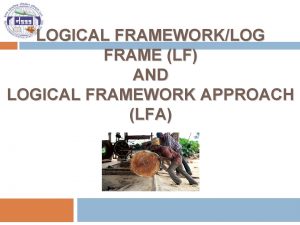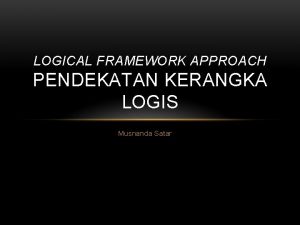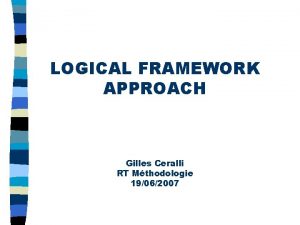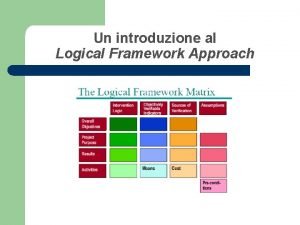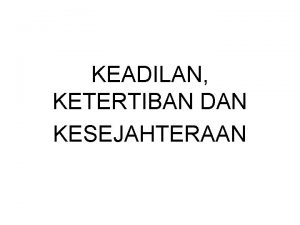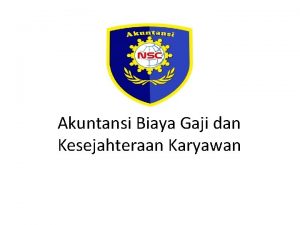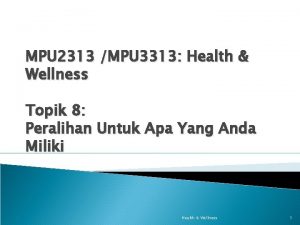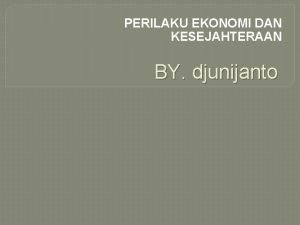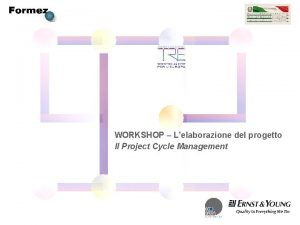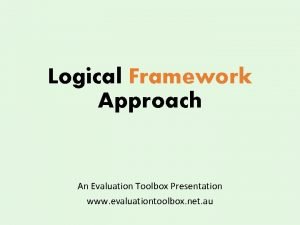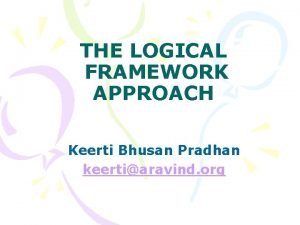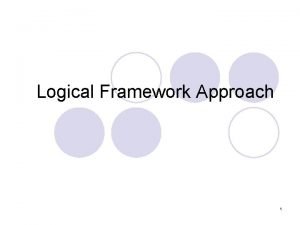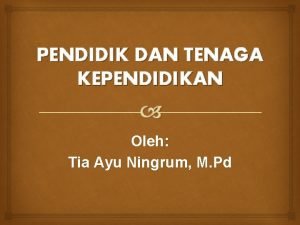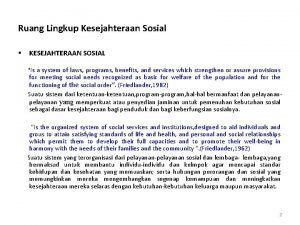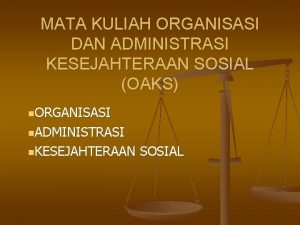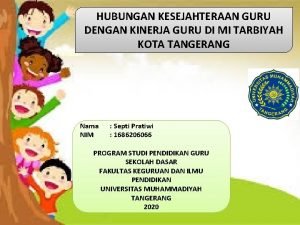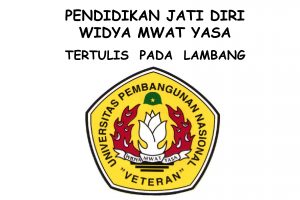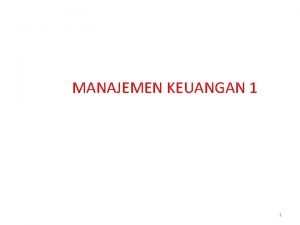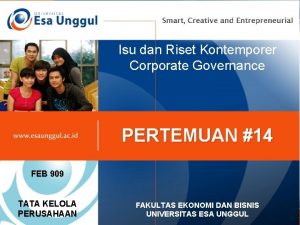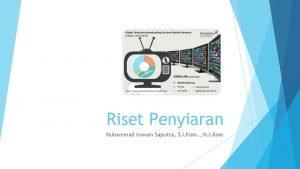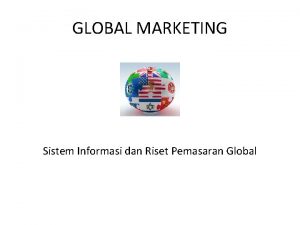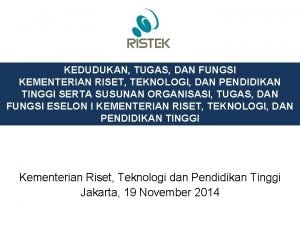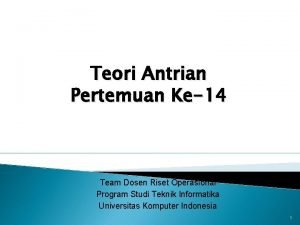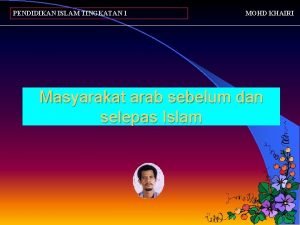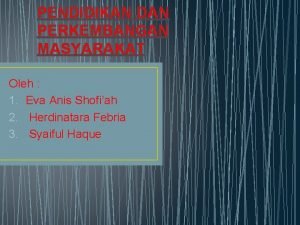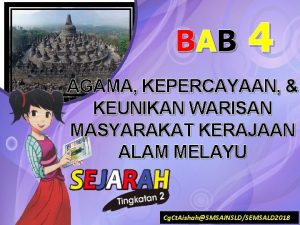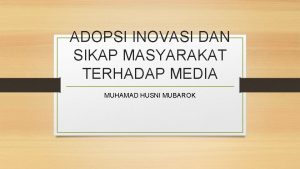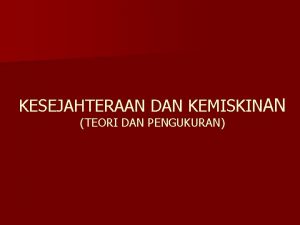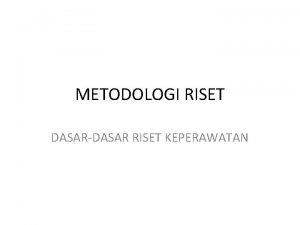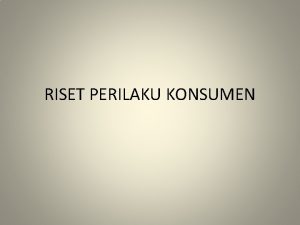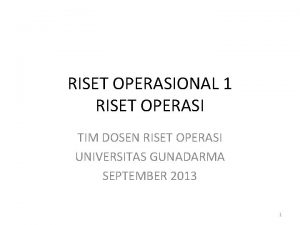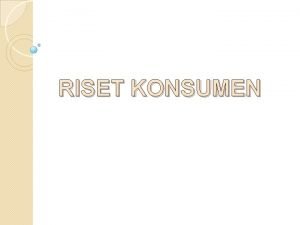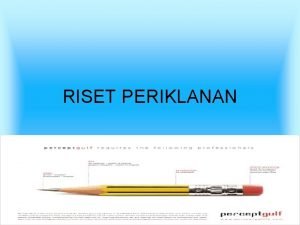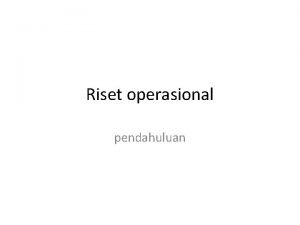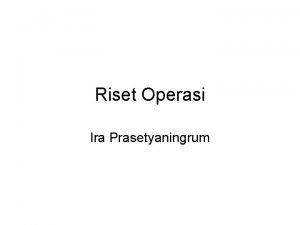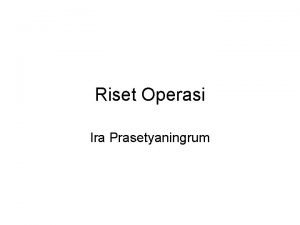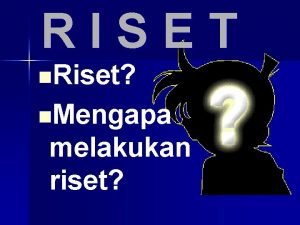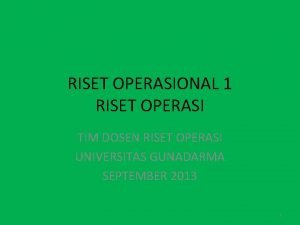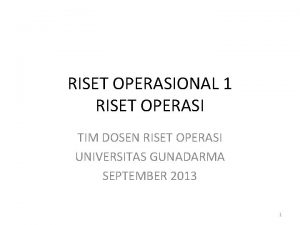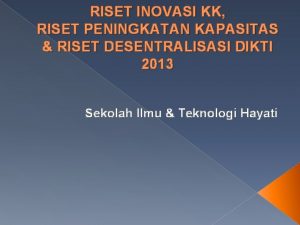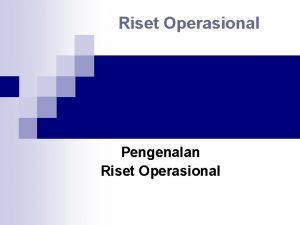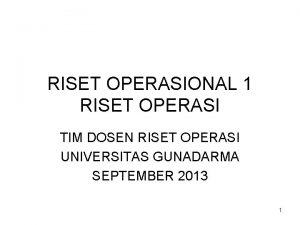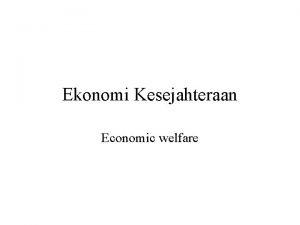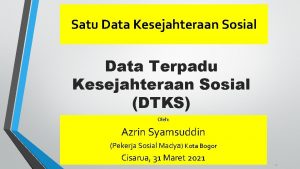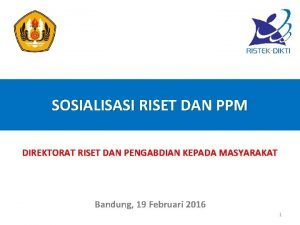Riset dan Kesejahteraan Masyarakat Logical Framework Approach 1


















































- Slides: 50

Riset dan Kesejahteraan Masyarakat: Logical Framework Approach 1

Isi n n Riset untuk masyarakat tidak layak publikasi internasional Menjamin Riset agar bermanfaat untuk masyarakat n n Kerangka Berpikir Tugas 2

Tetapi, ……. o Teknologi Tepat Guna sulit untuk Publikasi Internasional o Reputasi Ilmiah Kurang o Pengakuan untuk kenaikan pangkat sangat kurang



Project Success How? Engagement Ownership clearly defined Clear division of responsibilities Realism!! (purpose) Connection Activities – Objectives Capacity to handle risks Flexibility Beneficiaries engaged in project planning …. . LFA is a useful tool to reach success! 6

RBM and Logical Framework Approach (LFA) n The LFA is an RBM tool used for systematic planning, implementing, monitoring, and evaluating projects/ programmes. 7

LFA Characteristics Finding the “roots” before setting the objectives Objectives & beneficiary oriented Participatory/Ownership! Consensus oriented Focus on logical links Systematic common sense!!! 8

The Logical Framework Approach (i) Features of LFA : Ø Ø stakeholder involvement needs-based approach logical intervention approach framework for assessing relevance, feasibility and sustainability 9

The Logical Framework Approach (ii) Features of LFA : Ø results-oriented – not activity driven Ø logically sets objectives and their causal relationships Ø shows whether objectives have been achieved: Indicators (for M&E) Ø describes external factors that influence the project’s success: assumptions and risks 10

LFA Key Features Main steps: • Stakeholder Analysis • SWOT Analysis • Problem Tree Analysis • Objective Tree Analysis • Logical Framework Matrix • Monitoring and evaluation 11

Stakeholder Analysis Stakeholder is any individuals, group or organization, community, with an interest in the outcome of a programme/project. 12

Stakeholder Analysis Purpose: To identify: § The needs and interest of stakeholders § The organizations, groups that should be encouraged to participate in different stages of the project; § Potential risks that could put at risk programme; § Opportunities in implementing a programme; 13

SWOT Analysis (i) Purpose: n To assess the performance and capacity of the participating units, divisions of organization. n Each participating unit has to undertake SWOT analysis. 14

SWOT Analysis (ii) n SWOT analysis is a tool for institutional appraisal and a brainstorming exercise in which the representatives of the organization participate fully. 15

SWOT Analysis (iii) SWOT stands for: n Strengths - the positive internal attributes of the organisation n Weaknesses - the negative internal attributes of the organisation n Opportunities - external factors which could improve the organisation’s prospects n Threats - external factors which could undermine the organisation’s prospects 16

Problem Tree Analysis Purpose: - to identify major problems and their main causal relationships. Output: problem tree with cause and effects 17

Steps in Undertaking Problem Tree 1. 2. 3. Identify the major problems that the project will address. State problems in negative manner. Group problems by similarity of concerns. Develop the problem tree: a) b) c) Select a focal problem from the list and relate other problems to the focal problem. If the problem is a cause of the focal problem it is placed below the focal problem If the problem is an effect of the focal problem is goes above 18

Problem Tree EFFECT CAUSE 19

Analysis of Objectives n n Transforming the problem tree into an objectives tree by restating the problems as objectives. Problem statement converted in to positive statements Top of the tree is the end that is desired Lower levels are the means to achieving the end. 20

Objectives Tree * Ends * Project Cycle Management Guide, 2004 Means 21

The relationship between the problems tree and the objective tree PROBLEM TREE OBJECTIVE TREE n Focal problem Project Purpose n Effects Overall Objectives n Causes Results 22

Strategy Analysis (i) n n n The aim of strategy analysis is division of the objectives tree into more consistent smaller subunits that may, compose the core for a project. Each of the sub-units of the objective tree can represent an alternative strategy for the future project. The project objectives set the framework for the strategy of the project. 23

Strategy Analysis (ii) n Criteria for selection of the project strategy: 1. RELEVANCE: the strategy corresponds to the needs of the stakeholders. 2. EFFECTIVENESS: the lower level objectives of the strategy will contribute to achievement of the project purpose 3. EFFICIENCY: cost-effectiveness of the strategy in transforming the means into results. 4. CONSISTENT with development policies 5. SUSTAINABILITY of the project 6. ASSUMPTIONS and RISKS 24

The Logframe Matrix n The main output of the LFA is the logframe matrix. n n The Logical Framework Matrix is used to present information about project objectives, outputs and activities in a systematic and logical way. The basic Logframe matrix contains 16 cells organized into 4 columns and 4 rows, as indicated in the next slide: 25

The Logical Framework Matrix Objectives & activities Indicators Means of verification Assumptions Goal (Impact) Purpose/ (Outcome) Outputs Activities Means Cost What needs to be fulfilled before activities can start Pre-conditions 26

Assumptions (i) n n n Describe necessary internal and external conditions in order to ensure that the activities will produce results Assumptions are risks, which can jeopardize the success of the project Are worded positively, i. e. they describe circumstances required to achieve certain objectives 27

Assumptions (ii) n n n Should be relevant and probable If an assumption is not important or almost certain: Do not include If an assumption is unlikely to occur: Killer assumption – abandon project 28

Assumptions (iii) n Example of Assumptions for the Goal and Purpose: Political – stability of NSO and government staff n Economic – sustainable economy n Etc. n 29

Assumptions (iv) n Example of Assumptions: Adequate funds materials. n Skilled people – training needs. n Approvals & contracts – legal, administrative. n Participation of stakeholders. n 30

The logical framework Impact Outcome Assumptions Outputs Assumptions Activities Assumptions 31

Indicators (i) n n Indicators measure to verify to what extant the results are achieved. Specify how the achievement of an objective can be verified or demonstrated Provide a basis for Monitoring and Evaluation 3 Dimensions of Indicators n Quantity n Quality n Time 32

Indicators (ii) 33

Means of Verification n n Tools or means to obtain the information required by the indicators Include: n n n project documents field verification ad-hoc studies 34

Results Chain & Logical Framework Matrix RBM LFA Result Goal/Impact Result Purpose/ Outcome Result Output Result Activities 35

Monitoring and Evaluation n n Based on the logical framework Strengthens accountability and transparency Provides information for effective management Helps determine what works well and what requires improvement Builds knowledge 36

Purpose of Monitoring and Evaluation n It is the continuous process of collecting, processing and assessing information about the: n n Project implementation Project progress Project impact and effects Project environment 37

Monitoring (i) n Continuous function that aims to provide early indications of progress or lack thereof in the achievement of results 38

Monitoring (ii) n n Assumes the validity of the existing plan Takes place at project level Is the responsibility of the project management Is based on the indicators defined in the logical framework 39

Monitoring Responsibility n Project Management Activities n Output indicators n Early outcome indicators n n Project Target Group Outcome indicators n Impact indicators n 40

Evaluation n n Time-bound exercise to assess the relevance, performance and success of ongoing or completed projects Questions the validity of existing planning Is related to the impact of a project Opens the mind for strategic adjustments 41

Evaluation Quality Criteria n n n Relevance (overall) Efficiency (activities, outputs) Effectiveness (outputs, outcome) Impact (outcome, impact) Sustainability (outcome, impact) 42

The nine steps of an LFA analysis 1 2 3 4 5 6 7 8 9 Analysis of project´s Context Analysis of Stakeholders Problem Analysis/Situation Analysis Objectives Analysis Plan of Activities Plan of Resources/Inputs Indicators/measurements Risk Analysis of Assumptions 43

Why different steps in LFA? Relevance; Step 1 – 4 Context, Stakeholder-, Problem- and Objectives analysis. Logical links between problems and solutions, Relevant to support? (in accordance with strategies and problems in the country/sector? ) Feasible; Step 5 – 7 Plan of Activities, Resources/inputs and Indicators. Are the resources sufficient to achieve the objectives? (Resources: Personnel, time, funding, equipment) Sustainable; Step 8 – 9 Risk analysis and Assumptions. If the project is sustainable, will the effects of the project remain without continuos external assistance outside? 44

Internet information on LFA www. google. com/logical framework approach http: //www. ausaid. gov. au/ausguidelines/1. ht ml http: //lgausa. com/logframe_approach. htm http: //www. cgiar. org/isnar/gender/hambly. htm http: //www. pcm-group. com/services_helpdesk_faq. jsp http: //europa. eu. int/comm/europeaid/evaluation/metho ds/PCM_Manual_EN-march 2001. pdf 45

LFA summary Relevant, Feasible and Sustainable projects/programs - success! Participation & ownership! Joint approach to project Make problem analysis with accuracy /time to correctly analyze causes & effects Connection problems and objectives Add analysis such as cost effectiveness and gender, study on environmental aspects and make a clear division of responsibilities LFA during all phases of the project 46

How the LFA method works depends on its users LFA is no better and no worse than its users 47

Penilaian Tugas 5; Kelompok o LFA untuk pengembangan industri nilai tambah Kriteria 50 - 65 # pertemuan 1 -2 kali kelompok (10%) 65 - 80 80 - 100 3 kali Lebih dari 3 kali Notulen pertemuan (20%) Pendapat peserta dicatat dan disimpulkan Pendapat dicatat, disimpulka, langkah selanjutnya Penentuan Komoditi dan strategi (50%) Logical sequence lemah Logical sequence kuat Logical sequence sangat kuat Keterbacaan (20%) Sulit dibaca Mudah dibaca dengan lay out menarik 9/30/2020 Kuliah I, Metodologi Penelitian Ilmu Pangan 48

Penilaian Presentasi Kriteria 50 - 65 Kualitas Slide (40%) > 50 % berisi 25 - 50 % berisi kalimat panjang Artikulasi Penyampaian (40 %) Tidak jelas dan sulit dicerna Cukup jelas, masih ada yang sulit dicerna Sangat jelas dan mudah dicerna Jawaban terhadap pertanyaan (20 %) Tidak terjawab dengan baik Masih ada yang belum terjawab Terjawab dengan jelas dan memuaskan 9/30/2020 65 - 80 Kuliah I, Metodologi Penelitian Ilmu Pangan 80 - 100 49

Butir yang harus dibahas o Komoditi yang disepakati n o o Kemukakan alasan Penjabaran 9 langkah LFA untuk komoditi tersebut Problem tree Objective tree Matriks Program 9/30/2020 Kuliah I, Metodologi Penelitian Ilmu Pangan 50
 Peran masyarakat madani dalam mewujudkan kesejahteraan umat
Peran masyarakat madani dalam mewujudkan kesejahteraan umat Logical framework approach
Logical framework approach Logical framework
Logical framework Kerangka logis
Kerangka logis Logical framework approach
Logical framework approach Quadro logico
Quadro logico Keadilan ketertiban dan kesejahteraan
Keadilan ketertiban dan kesejahteraan Akuntansi biaya gaji dan kesejahteraan karyawan
Akuntansi biaya gaji dan kesejahteraan karyawan Mpu 2312
Mpu 2312 Perilaku ekonomi dan kesejahteraan
Perilaku ekonomi dan kesejahteraan Logical operators equivalence
Logical operators equivalence Kesetaraan logis
Kesetaraan logis Logical framework esempi
Logical framework esempi Logical framework matrix
Logical framework matrix Internal logical framework
Internal logical framework Logical framework
Logical framework Peran guru dalam administrasi ptk
Peran guru dalam administrasi ptk The importance of maintenance
The importance of maintenance Indikator masyarakat sejahtera
Indikator masyarakat sejahtera Ruang lingkup kesejahteraan sosial
Ruang lingkup kesejahteraan sosial Administrasi kesejahteraan sosial
Administrasi kesejahteraan sosial Sekretariat daerah provinsi dki jakarta
Sekretariat daerah provinsi dki jakarta Pengertian kesejahteraan guru
Pengertian kesejahteraan guru Contoh jati diri individu
Contoh jati diri individu Memantau kesejahteraan janin
Memantau kesejahteraan janin Financial decision adalah
Financial decision adalah Isu dan riset kontemporer corporate governance
Isu dan riset kontemporer corporate governance Riset rating dan non rating
Riset rating dan non rating Contoh soal dan penyelesaian mengenai metode penugasan
Contoh soal dan penyelesaian mengenai metode penugasan Sistem informasi dan riset pemasaran global
Sistem informasi dan riset pemasaran global Tugas kementerian riset, teknologi, dan pendidikan tinggi
Tugas kementerian riset, teknologi, dan pendidikan tinggi Melaksanakan riset pemasaran dan meramalkan permintaan
Melaksanakan riset pemasaran dan meramalkan permintaan Teori antrian
Teori antrian Differentiate between virtual circuit and datagram network
Differentiate between virtual circuit and datagram network Cognitive approach vs behavioral approach
Cognitive approach vs behavioral approach Country attractiveness matrix
Country attractiveness matrix Multiple approach-avoidance
Multiple approach-avoidance Cognitive approach vs behavioral approach
Cognitive approach vs behavioral approach Research approach meaning
Research approach meaning Traditional development approach
Traditional development approach Deep learning approach and surface learning approach
Deep learning approach and surface learning approach Dispositional framework vs regulatory framework
Dispositional framework vs regulatory framework Conceptual vs theoretical framework
Conceptual vs theoretical framework Theoretical framework maker
Theoretical framework maker Conceptual framework theoretical framework
Conceptual framework theoretical framework Dispositional framework vs regulatory framework
Dispositional framework vs regulatory framework Conceptual framework vs theoretical framework
Conceptual framework vs theoretical framework Akhlak baik masyarakat jahiliah
Akhlak baik masyarakat jahiliah Pendidikan dan perkembangan masyarakat
Pendidikan dan perkembangan masyarakat Tiga keunikan warisan dalam kerajaan alam melayu
Tiga keunikan warisan dalam kerajaan alam melayu Adopsi inovasi dan sikap masyarakat terhadap media
Adopsi inovasi dan sikap masyarakat terhadap media


